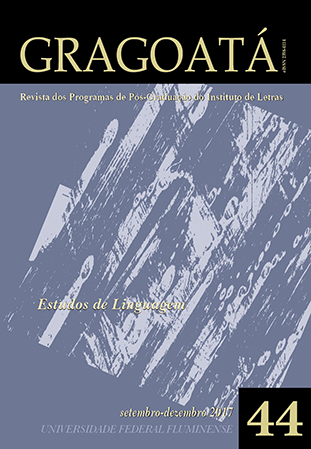Semiotics and Discourse Studies
DOI:
https://doi.org/10.22409/gragoata.v22i44.33548Keywords:
Discourse studies. Semiotic. Academic discourse. Greimas.Abstract
In this paper, I would like to discuss the contribution that post-structuralist semiotics has brought to the analysis of academic discourse. The semiotic model was developed initially for the analysis of tales and myths. It has been gradually extended to various forms of fiction (novels, short stories), and then, according to "a growing degree of complexity and abstraction", to all "forms of social production of meaning" (p. 5). This is the project stated in the first pages to a book entitled “Introduction to Discourse Analysis in Social Sciences” (A.J. Greimas & E. Landowski eds, 1979). The generalized extension is based on a typology of discourses that has been illustrated by specific analyses published in the 1980s (Bastide 1981, Bastide & Fabbri 1985, Landowski 1986, Bordron 1987). One may be considered that the research project led by Greimas and Landowski is thus located at the farthest point of development and initial application of the model and it is therefore a test for the narrative hypothesis. In doing so, the semiotic approach took the risk of being confronted with other models of analysis, such as they were elaborated in theoretical frameworks resulting from rhetoric (renewed in the 1950s by Chaim Perelman and his school ), pragmatics (cf Parret 1983 & 1987), sociology of knowledge (from the founding work of Berger & Luckmann 1966), or as they relate to other theoretical currents in the language sciences (in particular, In France, the Althusserian discourse analysis). For the discourse in social sciences, these models offer two advantages over that of semiotics: on the one hand, it seems that the theoretical postulates on which they are worked out are more directly in accord with this type of discourse; on the other hand, they can count on a solid tradition of studies to ensure the sustainability of the results. Nevertheless, the model of semiotic analysis is original and it has also an advantage: it is general. I will put forward the benefits of this generality.
---
DOI: http://dx.doi.org/10.22409/gragoata.2017n44a1033
Downloads
Downloads
Published
How to Cite
Issue
Section
License
Authors who publish in Gragoatá agree to the following terms:
The authors retain the rights and give the journal the right to the first publication, simultaneously subject to a Creative Commons license CC-BY-NC 4.0, which allows sharing by third parties with due mention to the author and the first publication by Gragoatá.
Authors may enter into additional and separate contractual arrangements for the non-exclusive distribution of the published version of the work (for example, posting it in an institutional repository or publishing it in a book), with recognition of its initial publication in Gragoatá.

Gragoatá is licensed under a Creative Commons - Attribution-NonCommercial 4.0 International.











